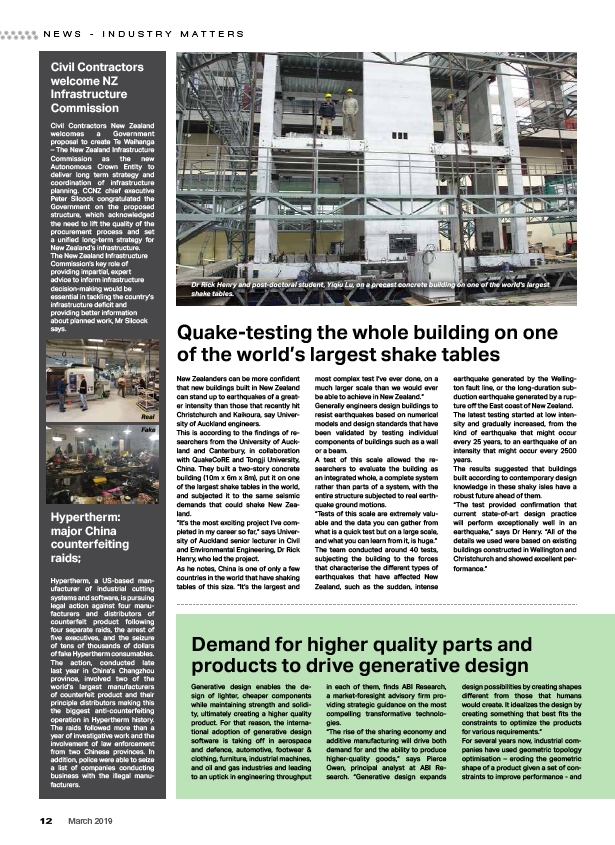
N E W S - I N D U S T R Y M A T T E R S
12 March 2019
Dr Rick Henry and post-doctoral student, Yiqiu Lu, on a precast concrete building on one of the world's largest
shake tables.
Quake-testing the whole building on one
of the world’s largest shake tables
New Zealanders can be more confident
that new buildings built in New Zealand
can stand up to earthquakes of a greater
intensity than those that recently hit
Christchurch and Kaikoura, say University
of Auckland engineers.
This is according to the findings of researchers
from the University of Auckland
and Canterbury, in collaboration
with QuakeCoRE and Tongji University,
China. They built a two-story concrete
building (10m x 6m x 8m), put it on one
of the largest shake tables in the world,
and subjected it to the same seismic
demands that could shake New Zealand.
“It’s the most exciting project I’ve completed
in my career so far,” says University
of Auckland senior lecturer in Civil
and Environmental Engineering, Dr Rick
Henry, who led the project.
As he notes, China is one of only a few
countries in the world that have shaking
tables of this size. “It’s the largest and
most complex test I’ve ever done, on a
much larger scale than we would ever
be able to achieve in New Zealand.”
Generally engineers design buildings to
resist earthquakes based on numerical
models and design standards that have
been validated by testing individual
components of buildings such as a wall
or a beam.
A test of this scale allowed the researchers
to evaluate the building as
an integrated whole, a complete system
rather than parts of a system, with the
entire structure subjected to real earthquake
ground motions.
“Tests of this scale are extremely valuable
and the data you can gather from
what is a quick test but on a large scale,
and what you can learn from it, is huge.”
The team conducted around 40 tests,
subjecting the building to the forces
that characterise the different types of
earthquakes that have affected New
Zealand, such as the sudden, intense
earthquake generated by the Wellington
fault line, or the long-duration subduction
earthquake generated by a rupture
off the East coast of New Zealand.
The latest testing started at low intensity
and gradually increased, from the
kind of earthquake that might occur
every 25 years, to an earthquake of an
intensity that might occur every 2500
years.
The results suggested that buildings
built according to contemporary design
knowledge in these shaky isles have a
robust future ahead of them.
“The test provided confirmation that
current state-of-art design practice
will perform exceptionally well in an
earthquake,” says Dr Henry. “All of the
details we used were based on existing
buildings constructed in Wellington and
Christchurch and showed excellent performance.”
Demand for higher quality parts and
products to drive generative design Generative design enables the design
of lighter, cheaper components
while maintaining strength and solidity,
ultimately creating a higher quality
product. For that reason, the international
adoption of generative design
software is taking off in aerospace
and defence, automotive, footwear &
clothing, furniture, industrial machines,
and oil and gas industries and leading
to an uptick in engineering throughput
in each of them, finds ABI Research,
a market-foresight advisory firm providing
strategic guidance on the most
compelling transformative technologies.
“The rise of the sharing economy and
additive manufacturing will drive both
demand for and the ability to produce
higher-quality goods,” says Pierce
Owen, principal analyst at ABI Research.
“Generative design expands
design possibilities by creating shapes
different from those that humans
would create. It idealizes the design by
creating something that best fits the
constraints to optimize the products
for various requirements.”
For several years now, industrial companies
have used geometric topology
optimisation – eroding the geometric
shape of a product given a set of constraints
to improve performance - and
Civil Contractors
welcome NZ
Infrastructure
Commission
Civil Contractors New Zealand
welcomes a Government
proposal to create Te Waihanga
– The New Zealand Infrastructure
Commission as the new
Autonomous Crown Entity to
deliver long term strategy and
coordination of infrastructure
planning. CCNZ chief executive
Peter Silcock congratulated the
Government on the proposed
structure, which acknowledged
the need to lift the quality of the
procurement process and set
a unified long-term strategy for
New Zealand’s infrastructure.
The New Zealand Infrastructure
Commission’s key role of
providing impartial, expert
advice to inform infrastructure
decision-making would be
essential in tackling the country’s
infrastructure deficit and
providing better information
about planned work, Mr Silcock
says.
Real
Fake
Hypertherm:
major China
counterfeiting
raids;
Hypertherm, a US-based manufacturer
of industrial cutting
systems and software, is pursuing
legal action against four manufacturers
and distributors of
counterfeit product following
four separate raids, the arrest of
five executives, and the seizure
of tens of thousands of dollars
of fake Hypertherm consumables.
The action, conducted late
last year in China’s Changzhou
province, involved two of the
world’s largest manufacturers
of counterfeit product and their
principle distributors making this
the biggest anti-counterfeiting
operation in Hypertherm history.
The raids followed more than a
year of investigative work and the
involvement of law enforcement
from two Chinese provinces. In
addition, police were able to seize
a list of companies conducting
business with the illegal manufacturers.